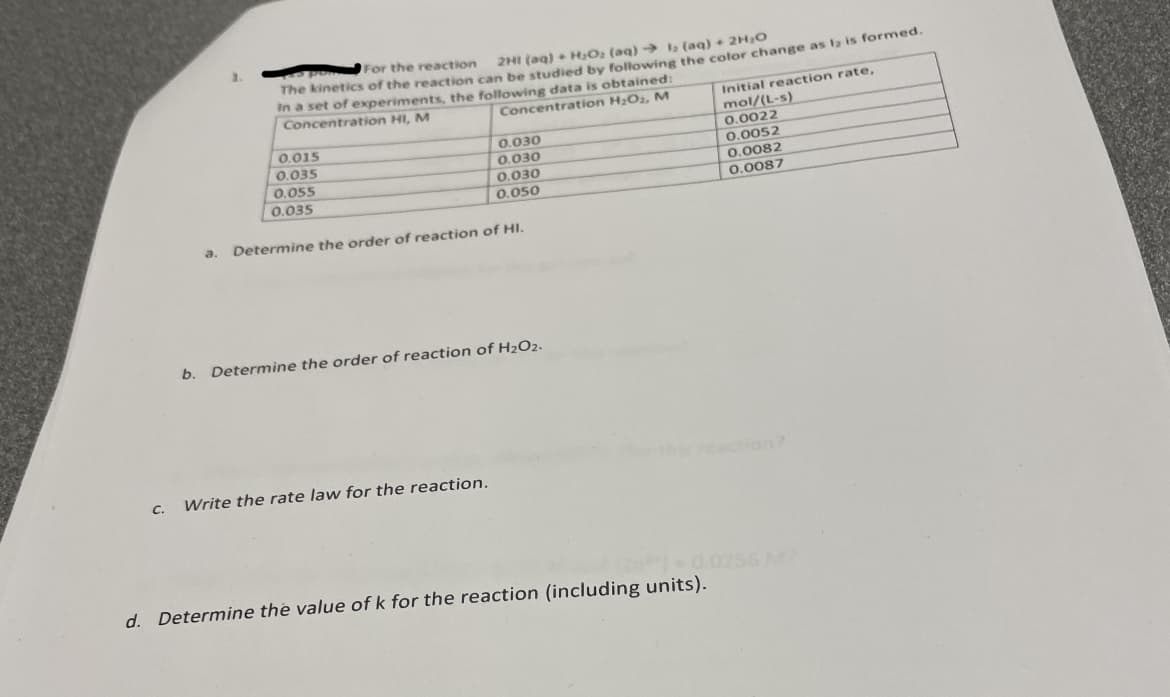C. For the reaction 2H1 (aq) + H₂O₂ (aq) → 1₂ (aq) + 2H₂O The kinetics of the reaction can be studied by following the color change as la is formed. In a set of experiments, the following data is obtained: Concentration HI, M Concentration H₂O₂, M 0.015 0.035 0.055 0.035 0.030 0.030 0.030 0.050 a. Determine the order of reaction of HI. b. Determine the order of reaction of H₂O2. Write the rate law for the reaction. Initial reaction rate, mol/(L-s) 0.0022 0.0052 0.0082 0.0087 reaction?
C. For the reaction 2H1 (aq) + H₂O₂ (aq) → 1₂ (aq) + 2H₂O The kinetics of the reaction can be studied by following the color change as la is formed. In a set of experiments, the following data is obtained: Concentration HI, M Concentration H₂O₂, M 0.015 0.035 0.055 0.035 0.030 0.030 0.030 0.050 a. Determine the order of reaction of HI. b. Determine the order of reaction of H₂O2. Write the rate law for the reaction. Initial reaction rate, mol/(L-s) 0.0022 0.0052 0.0082 0.0087 reaction?
Chemistry & Chemical Reactivity
9th Edition
ISBN:9781133949640
Author:John C. Kotz, Paul M. Treichel, John Townsend, David Treichel
Publisher:John C. Kotz, Paul M. Treichel, John Townsend, David Treichel
Chapter14: Chemical Kinetics: The Rates Of Chemical Reactions
Section: Chapter Questions
Problem 65GQ: The thermal decomposition of diacetylene, C4H2, was studied at 950 C. Use the following data (K. C....
Related questions
Question
1 a-c

Transcribed Image Text:C.
b.
For the reaction
2H1 (aq) + H₂O₂ (aq) → 12 (aq) + 2H₂O
The kinetics of the reaction can be studied by following the color change as ta is formed.
In a set of experiments, the following data is obtained:
Concentration HI, M
Concentration H₂O₂, M
0.015
0.035
0.055
0.035
0.030
0.030
0.030
0.050
a. Determine the order of reaction of HI.
Determine the order of reaction of H₂O2.
Write the rate law for the reaction.
Initial reaction rate,
mol/(L-s)
0.0022
0.0052
0.0082
0.0087
-0.0256 M?
d. Determine the value of k for the reaction (including units).
Expert Solution
This question has been solved!
Explore an expertly crafted, step-by-step solution for a thorough understanding of key concepts.
Step by step
Solved in 3 steps with 3 images

Knowledge Booster
Learn more about
Need a deep-dive on the concept behind this application? Look no further. Learn more about this topic, chemistry and related others by exploring similar questions and additional content below.Recommended textbooks for you

Chemistry & Chemical Reactivity
Chemistry
ISBN:
9781133949640
Author:
John C. Kotz, Paul M. Treichel, John Townsend, David Treichel
Publisher:
Cengage Learning

Chemistry & Chemical Reactivity
Chemistry
ISBN:
9781337399074
Author:
John C. Kotz, Paul M. Treichel, John Townsend, David Treichel
Publisher:
Cengage Learning

Chemistry for Engineering Students
Chemistry
ISBN:
9781337398909
Author:
Lawrence S. Brown, Tom Holme
Publisher:
Cengage Learning

Chemistry & Chemical Reactivity
Chemistry
ISBN:
9781133949640
Author:
John C. Kotz, Paul M. Treichel, John Townsend, David Treichel
Publisher:
Cengage Learning

Chemistry & Chemical Reactivity
Chemistry
ISBN:
9781337399074
Author:
John C. Kotz, Paul M. Treichel, John Townsend, David Treichel
Publisher:
Cengage Learning

Chemistry for Engineering Students
Chemistry
ISBN:
9781337398909
Author:
Lawrence S. Brown, Tom Holme
Publisher:
Cengage Learning

Chemistry by OpenStax (2015-05-04)
Chemistry
ISBN:
9781938168390
Author:
Klaus Theopold, Richard H Langley, Paul Flowers, William R. Robinson, Mark Blaser
Publisher:
OpenStax

Chemistry: Principles and Practice
Chemistry
ISBN:
9780534420123
Author:
Daniel L. Reger, Scott R. Goode, David W. Ball, Edward Mercer
Publisher:
Cengage Learning

Chemistry
Chemistry
ISBN:
9781305957404
Author:
Steven S. Zumdahl, Susan A. Zumdahl, Donald J. DeCoste
Publisher:
Cengage Learning